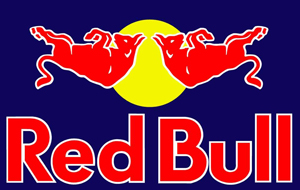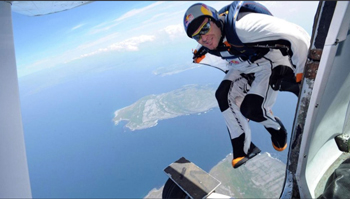Ride or die. As imaging technology advances and gets ever more powerful, so do the challenges promoted by action sports. Higher, faster, ever more foolish. Equipped with the latest action cam, people risk their life for the ultimate footage. The images we enjoy are breathtaking indeed. A millisecond separates the daring stunts from the abyss. There are winners, the best among the brave. And there are losers, who pay with the ultimate sacrifice, their life.

In fact much of the extreme footage we enjoy is the product and the world of Red Bull, the Austrian energy drink giant that likes to promote its brand by promising spectacles with no limits. For the daredevils themselves their action-loaded life would be unthinkable without the incentives promised by Red Bull — and of course the ever growing list of high quality action cameras mounted on the stuntmen’s helmets.
Red Bull’s marketing strategy is unique in the world — and one of the reasons why the company’s sales are growing steadily. In 2015 alone, they sold some six billion cans in 169 countries, with sales rising 15 percent year-on-year.
Parts of this marketing model are Red Bull Illume, “world’s greatest international photography contest dedicated to action and adventure sports” (co-sponsored by Sony), Red Bull Air Force, praising itself for “The Adrenaline. The Insanity. The Vibe.”, and Red Bull Rampage, a mountain bike contest that not always ends with trophies, but also fatalities.
Red Bull extreme action has a dark side. Even well-trained extreme sportsmen sometimes overestimate their boundaries. Not every accident ends as light as those you see on Red Bull’s YouTube channel:
At least seven people died in the past seven years during Red Bull events. The last known Red Bull death was the one of South African world champion and Red Bull stunt pilot Michel Leusch in August 2016 during a flight show in China.
The youngest of victims since 2007 is Toriano Wilson, 14, who was run over by another vehicle and killed at a Red Bull motorcycling event in 2008. Of course it’s all captured on camera, because having footage was what these action stunts were all about. But you have trouble finding such footage on the Net. Red Bull is careful in not having such material publicized.

Or take November 11, 2009: Swiss base jumper Ueli Gegenschatz jumped from an 88-meter building in Zurich for a Red Bull advertising campaign. He hit an edge of the tower and then hit the ground. Two days later the 38-year-old succumbed to his injuries.
Or Japanese athlete Eigo Sato. He died on February 28, 2013, during a race. Seven weeks after the accident, Sato was still listed on a Red Bull website. Meaning not even a brand-related death seems to tarnish the brand. Maybe on the contrary.
And the Red Bull sponsored heroes who turn victim are just the tip of the iceberg. The ascent of ever more powerful camera gear led to an avalanche of extreme sportsmen who show off their achievements on own websites and video channels. If they’re lucky they’re sponsored. And still alive.
A beneficiary of the Red Bull marketing machine is 18-year-old Luc Ackermann. The German freestyle motocross rider is a professional action sportsman. Discovered at the age of 16, he was given the Red Bull helmet — every extreme sportsman’s dream. Whoever carries the logo of the company with the two rod bulls on his helmet, is one of those chosen ones who have made it.
The helmet also serves as an entrance ticket to an empire in which things are possible that seem impossible. Formula 1 driver Sebastian Vettel and Felix Baumgartner, who jumped from the stratosphere to earth, are two examples of Red Bull sponsoring.
It’s a privilege to be a Red Bull athlete. The Red Bull helmet is such a coveted trophy, athletes are queuing up for risky competitions that don’t allow the slightest mistakes. The pressure is growing steadily, since action sport lives from the audience’s adrenaline kicks.
Many athletes who try to live their dream have to suffer great pain. Ackermann is currently forced to take a break. In September, the thighs broke during a training accident. “Got surgery,” he tweeted, and “can’t wait to be back on my bike!”
Such accidents are common. Travis Pastrana, an icon of extreme sports, broke his right foot 40 times in the two decades of his career. That’s not to mention all the other injuries.
Do Ackermann and Pastrana have to blame themselves? Lucrative sponsorship agreements are so rare that they are usually not negotiated. They are awarded to the best, so the only chance you have is to give it everything, and if it is your life.
One of the few who broke out of this dangerous world is Cameron “Cam” Zinc. During the Red Bull Rampage in 2015, the 30-year-old made this #fuckrampage Instagram statement about his fellow rider Paul Basagoitia who just survived a drop that Zink described as the “record for biggest step down”, caught — of course — on camera.
Zink was clearly unhappy with the risks riders have to take when competing for Red Bull. Basagoitia fell down a cliff and suffered a chest fracture with separated nerve cords. In 2015 alone, 7 of the 42 invited Rampage riders landed in hospital.

Red Bull’s extreme sports events display an unbearable symbol of the cynicism and the perversion of event marketing. In order to stay in business, Canadian professional skier and base jumper Shane McConkey perceived himself as challenged to perform ever-more reckless acts — like combining extreme skiing and base jumping.
We enjoy the footage. Red Bull enjoys higher sales. While athletes are placed under growing pressure to undertake ever riskier challenges to secure sponsorship.
This didn’t stop Red Bull from releasing the documentary Shane McConkey: You Have One Life. Live it — after the Canadian fell to his death attempting to base jump from a cliff in the Dolomites.
Red Bull has developed a marketing strategy that is without any competition, because no-one else dares to elevate dangerous living to a way of life and program.
As gear improves and pressure mounts, also the physical boundaries must keep getting pushed. It always has to go farther.
Who’s next.
More athletes will risk it all to earn their dream trophy, the coveted Red Bull helmet, in the hunt for ever more dramatic footage.


